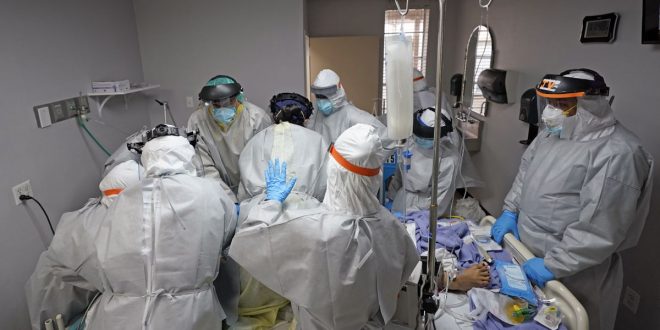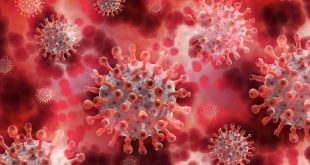/www.theglobeandmail.com/files/dev/uxtest/coronahub/the-zero-canada-project-200x160.png)
Coronavirus information
The Zero Canada Project provides resources to help you make the most of staying home.
Washington
Getting audio file…
Audio for this article is not available at this time.
This translation has been automatically generated and has not been verified for accuracy. Full Disclaimer
Dr. Joseph Varon, right, leads a team as they try to save the life of a patient unsuccessfully inside the Coronavirus Unit at United Memorial Medical Center on July 6, 2020, in Houston.
David J. Phillip/The Associated Press
On the first day of summer, 300 Texas high-school students gathered for a “Pong Fest” party in the wealthy Lakeway suburb of Austin. Some of the teens had recently received tests for COVID-19, but did not bother waiting for the results before going to the gathering. As it turned out, several were positive for the novel coronavirus and exposed a swath of their peers. In the weeks that followed, Lakeway’s cases more than doubled, to 219 from 105.
While the party may have been reckless, it also appears to have been legal. At the time, gatherings of up to 500 people were allowed in the state despite the pandemic.
The episode is emblematic of the country’s coronavirus resurgence: disproportionately affecting young people, exploding in states with a lax attitude to public health and fuelled by attempts to swiftly lift physical-distancing measures.
The U.S. has now notched more than 3.2 million cases. Its infection rate is 9,730 per million, more than four times that of Canada. On Thursday, there were 60,500 new cases, more than any country has ever recorded in a single day.

counties most vulnerable
to coronavirus
While major U.S. cities have been hard hit by
COVID-19, rural and semi-rural counties are highly
vulnerable to infection because of a number of com-
bined issues. David J. Peters of Iowa State University
created a county-level scale using risk factors for
COVID-19 to analyze community susceptibility and
resiliency to the current pandemic. Factors such as
population density, percentage of elderly, those
living in group quarters or institutional settings and
health status were considered. The study concluded
that non-metropolitan counties, including rural,
were more vulnerable to the disease than metro-
politan areas.The findings were published in the
Journal of Rural Health.
COVID-19 Susceptibility Scores
By Quintiles, survey of 3,079 counties
0-19%
20-39%
40-59%
60-79%
80-100%
JOHN SOPINSKI and murat yÜkselir/THE GLOBE
AND MAIL, SOURCE: david j. peters, journal of
rural health

counties most vulnerable
to coronavirus
While major U.S. cities have been hard hit by COVID-19,
rural and semi-rural counties are highly vulnerable to
infection because of a number of combined issues.
David J. Peters of Iowa State University created a county-
level scale using risk factors for COVID-19 to analyze
community susceptibility and resiliency to the current
pandemic. Factors such as population density, percentage
of elderly, those living in group quarters or institutional
settings and health status were considered. The study
concluded that non-metropolitan counties, including rural,
were more vulnerable to the disease than metropolitan
areas.The findings were published in the Journal of
Rural Health.
COVID-19 Susceptibility Scores
By Quintiles, survey of 3,079 counties
20-39%
40-59%
60-79%
0-19%
80-100%
JOHN SOPINSKI and murat yÜkselir/THE GLOBE AND MAIL
SOURCE: david j. peters, journal of rural health

counties most vulnerable to coronavirus
While major U.S. cities have been hard hit by COVID-19, rural and semi-rural counties are highly
vulnerable to infection because of a number of combined issues. David J. Peters of Iowa State
University created a county-level scale using risk factors for COVID-19 to analyze community
susceptibility and resiliency to the current pandemic. Factors such as population density, per-
centage of elderly, those living in group quarters or institutional settings and health status were
considered. The study concluded that non-metropolitan counties, including rural, were more
vulnerable to the disease than metropolitan areas.The findings were published
in the Journal of Rural Health.
COVID-19
Susceptibility
Scores
By Quintiles
Survey of 3,079
counties
0-19%
20-39%
40-59%
60-79%
80-100%
JOHN SOPINSKI and murat yÜkselir/THE GLOBE AND MAIL
SOURCE: david j. peters, journal of rural health
Epidemiologists point to several reasons. For one, numerous Southern and rural states were quick to lift containment measures, sometimes ending lockdown orders after as little as one month. For another, patchwork public-health infrastructure has hampered efforts to isolate and tamp down outbreaks.
California dreaming: From pandemic role model to cautionary tale
And many jurisdictions have allowed vectors of transmission, from megachurch services to Donald Trump rallies, to go ahead. Even weather may play a part, with summer heat driving more Sun Belt residents indoors.
More than two-thirds of states currently have rising case counts. The worst-hit have mostly been ones that only briefly imposed physical-distancing rules.
In Arizona, for instance, Governor Doug Ducey lifted the state’s stay-at-home order on May 15 and urged constituents to immediately resume normal life. “I want to encourage people to get out and about, to take a loved one to dinner, to go retail shopping,” he told KTAR radio Phoenix in May. “It’s safe out there.”
COVID-19 news: Updates and essential resources about pandemic
Now, Arizona is experiencing the fastest caseload rise of any state, with a growth rate triple that of the country as a whole. On Thursday, it added 4,073 new coronavirus cases on a day where Canada marked 371.
Florida’s daily case count, meanwhile, has increased more than tenfold since the state reopened bars in June. In neighbouring Georgia, that figure has tripled since the state became the first to end stay-at-home directives in April. In South Carolina, daily numbers have nearly quadrupled over the past month.
In Texas, Governor Greg Abbott appeared reluctant to enforce his own physical-distancing orders. When Dallas hairdresser Shelley Luther repeatedly refused to close down her salon, Mr. Abbott lobbied for her not to be punished. Texas’s COVID-19 death rate is up more than 300 per cent over the past six weeks.

COVID-19 CASE TRENDS,
BY SELECTED STATES
As of July 9
Daily cases
7-day moving average
ARIZONA
Cases: 112,671
Deaths: 1,076
4,000
2,000
March
April
May
June
July
FLORIDA
Cases: 232,718
Deaths: 2,765
10,000
5,000
March
April
May
June
July
GEORGIA
Cases: 106,727
Deaths: 2,285
2,000
March
April
May
June
July
MISSISSIPPI
Cases: 33,591
Deaths: 847
1,000
March
April
May
June
July
SOUTH CAROLINA
Cases: 50,691
Deaths: 568
1,000
March
April
May
June
July
TEXAS
Cases: 236,541
Deaths: 1,867
10,000
5,000
March
April
May
June
July
THE GLOBE AND MAIL, SOURCE:
JOHNS HOPKINS UNIVERSITY

COVID-19 CASE TRENDS,
BY SELECTED STATES
As of July 9
Daily cases
7-day moving average
ARIZONA
Cases: 112,671
Deaths: 1,076
4,000
2,000
March
April
May
June
July
FLORIDA
Cases: 232,718
Deaths: 2,765
10,000
5,000
March
April
May
June
July
GEORGIA
Cases: 106,727
Deaths: 2,285
2,000
March
April
May
June
July
MISSISSIPPI
Cases: 33,591
Deaths: 847
1,000
March
April
May
June
July
SOUTH CAROLINA
Cases: 50,691
Deaths: 568
1,000
March
April
May
June
July
TEXAS
Cases: 236,541
Deaths: 1,867
10,000
5,000
March
April
May
June
July
THE GLOBE AND MAIL, SOURCE: JOHNS HOPKINS UNIVERSITY

COVID-19 CASE TRENDS, BY SELECTED STATES
As of July 9
Daily cases
7-day moving average
ARIZONA
FLORIDA
Cases: 112,671
Deaths: 1,076
Cases: 232,718
Deaths: 2,765
10,000
4,000
5,000
2,000
March
April
May
June
July
March
April
May
June
July
MISSISSIPPI
GEORGIA
Cases: 33,591
Deaths: 847
Cases: 106,727
Deaths: 2,285
1,000
2,000
March
April
May
June
July
March
April
May
June
July
SOUTH CAROLINA
TEXAS
Cases: 50,691
Deaths: 568
Cases: 236,541
Deaths: 1,867
10,000
1,000
5,000
March
April
May
June
July
March
April
May
June
July
THE GLOBE AND MAIL, SOURCE: JOHNS HOPKINS UNIVERSITY
California, meanwhile, was the first to impose a lockdown in March and avoided the worst throughout the spring. But after Governor Gavin Newsom loosened the rules, allowing cities to lift restrictions, cases have spiked.
“In the U.S., they were on that path to flattening the curve, but the early reopening meant that you hadn’t got it under control,” Dr. Prabhat Jha, an epidemiologist at the University of Toronto, said in an interview. “I don’t call this a second wave. I call this an unfinished first wave.”
The current surge is most prevalent among younger people, suggesting that they may be more willing to risk exposure than older Americans. This could explain why, despite the rise in infections, the U.S.‘s daily death rate is currently only a quarter what it was in April.
Many states have also failed to put in place public-health infrastructure to contain the virus. In the Miami area, local mayors say, the state has hired so few contact tracers that only 17 per cent of people who test positive for COVID-19 are contacted by the program.
“Eighty per cent of the people that are told they’re positive are not given instructions, their contacts are not reached out to, they are not told to be … quarantined,” Miami Beach Mayor Dan Gelber said outside Miami City Hall.
Jay Kaufman, an epidemiologist at McGill University, also pointed to major transmission spots that U.S. authorities have not controlled: Cramped slaughterhouses and crowded prisons have helped drive outbreaks, while Florida and other states declared churches “essential” and allowed thousands to keep attending services in person.
And the U.S.‘s weak social-safety net, Prof. Kaufman said, has put more pressure on people to go back to work in unsafe conditions than those in Canada have experienced.
“They have greater economic inequality, a large chunk of the population without access to health care, unemployment benefits that are more stingy and harder to access, and more meagre assistance for housing and food insecurity, especially so in the Southern states,” he told The Globe and Mail.

The harder the fall, the bigger the bounce
Merchandise exports by industry, % change, May 2020
Monthly change, May
Year-to-year change, May
Motor vehicles and parts
Energy products
Aircraft and other transp.
equipment and parts
Basic and industrial chemical,
plastic and rubber products
Metal ores and non-metallic
minerals
Industrial machinery,
equipment and parts
Electronic and electrical
equipment and parts
Forestry products and bldg.
and packaging materials
Metal and non-metallic
mineral products
Consumer goods
Farm, fishing and
intermediate food products
-80
-60
-40
-20
20
40
60
80%
JOHN SOPINSKI/THE GLOBE AND MAIl
SOURCE: Export Development Canada

The harder the fall, the bigger the bounce
Merchandise exports by industry, % change, May 2020
Monthly change, May
Year-to-year change, May
Motor vehicles and parts
Energy products
Aircraft and other transp.
equipment and parts
Basic and industrial chemical,
plastic and rubber products
Metal ores and non-metallic
minerals
Industrial machinery,
equipment and parts
Electronic and electrical
equipment and parts
Forestry products and bldg.
and packaging materials
Metal and non-metallic
mineral products
Consumer goods
Farm, fishing and
intermediate food products
-80
-60
-40
-20
20
40
60
80%
JOHN SOPINSKI/THE GLOBE AND MAIl
SOURCE: Export Development Canada

The harder the fall, the bigger the bounce
Merchandise exports by industry, % change, May 2020
Monthly change, May
Year-to-year change, May
Motor vehicles and parts
Energy products
Aircraft and other transp.
equipment and parts
Basic and industrial chemical,
plastic and rubber products
Metal ores and non-metallic
minerals
Industrial machinery,
equipment and parts
Electronic and electrical
equipment and parts
Forestry products and building
and packaging materials
Metal and non-metallic
mineral products
Consumer goods
Farm, fishing and intermediate
food products
-80
-60
-40
-20
20
40
60
80%
JOHN SOPINSKI/THE GLOBE AND MAIL, SOURCE: Export Development Canada
Canada also has the advantage of more tolerable summer weather, which pushes people outdoors, he said, while sweltering heat in the South incentivizes Americans to go into air-conditioned buildings where the risk of infection is greater.
Mr. Trump insists that cases are rising only because the country is testing more. But the number of cases is actually increasing more quickly than the frequency of testing. Public-health officials in Tulsa, Okla., said this week that the city had seen an abrupt rise in infections as a result of a rally the President held there last month.
Some states driving the current surge have begun reinstating some measures. Florida, Arizona and Texas have re-closed bars. Two weeks after the Pong Fest party, Mr. Abbott banned gatherings of more than 10 people.
It is not clear, however, whether they are doing enough. This week, Mr. Ducey declined to reimpose a stay-at-home order. Rather, he said, it was up to people of his state to ride out the escalating pandemic as best they can.
“This is a good excuse to, whatever series your friends have talked about on Netflix, to watch it,” he said. “We’re going to be living with this virus for the foreseeable future.”
See behind the scenes at Houston Methodist Hospital as COVID-19 cases soar across the U.S. and hospitals struggle to keep up.
Our Morning Update and Evening Update newsletters are written by Globe editors, giving you a concise summary of the day’s most important headlines. Sign up today.
 The Argus Report Read about it!
The Argus Report Read about it!





